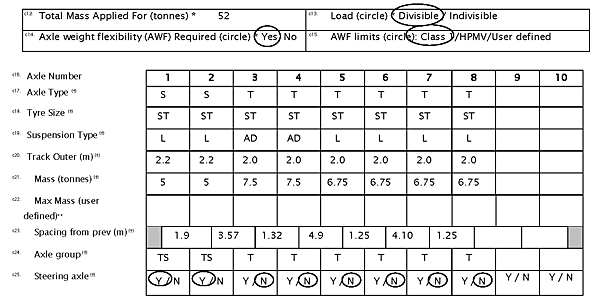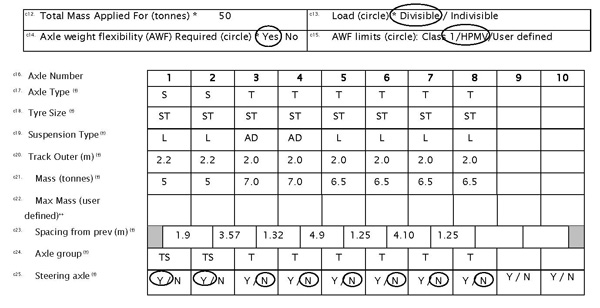The NZ Transport Agency offers two axle weight flexibility (AWF) options:
These options are made available to allow operators to maximise their gross load on the permitted route.
When applying for an HPMV permit, operators are able to consider and opt for either no axle flexibility, or one of two different axle weight flexibility options.
Compliance is required with the specified individual axle mass limits, the specified axle set mass limits, the specified axle group mass limits and the gross mass limit to ensure damage to road structures does not occur. Vehicles must also meet all required safety standards (eg brakes, static roll threshold and towing connection requirements).
There are two AWF options:
Before you apply, you will need to check the maximum mass limits of your vehicle, because your permit will not be able to exceed these limits. The final permitted mass limits may be reduced further by road structure limitations on your nominated route.
At the very least, you will need to check the following limits for your vehicle before applying:
maximum mass limit based on the first to last axle spacing (find out more)
maximum mass limits on critical axle groups depending on the type of vehicle you have (eg axles 1-4, 5-8, 3-6, 3-8 and 1-8 for R22T22) (find out more)
gross vehicle mass (GVM) and gross combination mass (GCM) from your certificate of loading
brake capacity
static roll threshold (SRT) for the mass you want to apply for
tow connection ratings.
The effects of AWF can be seen by looking at the example of a truck and full trailer, shown below (type R22T22 vehicle):

The maximum gross mass limit of the HPMV above is 54,000kg over the 18.29m wheelbase. This is the maximum mass that the HPMV is able to achieve on an unrestricted route. However, the gross mass applied for may be less than the maximum HPMV limit due to critical structures on a route, vehicle carrying capacity limiting its gross mass, or other economic reasons. Through applying for permits, and discussions with Transport Agency permit issuing officers (PIOs), the maximum achievable gross mass for a particular vehicle on a particular route can be determined – see our maps of proposed HPMV routes for more information.
By requesting AWF, the load effects caused by a particular vehicle may increase. This may result in the maximum achievable gross mass for a particular vehicle being reduced, compared with the ‘no flexibility’ case. HPMV applicants need to first determine whether they require AWF, and secondly what level of AWF is required. The higher the level of flexibility (eg HPMV AWF instead of Class 1 AWF), the higher the potential reduction in gross mass.
The following sections show examples of each AWF option for the vehicle R22T22, truck and full trailer detailed above. The total mass applied for is shown to reduce with increased levels of flexibility requested. This is to highlight the reduction in the gross mass achievable if there are critical structures on a route. However, it should be noted that if a route is unrestricted, requesting AWF may not result in any reduction in gross mass.
This option should be selected where the distribution of load to the HPMV's axles is able to be reliably achieved, although there's a very high risk with the load distribution not being met:
The vehicle axle mass limits are chosen by the applicant, up to the mass limits for individual axle(s) or axle sets, as per tables 1 to 5 of schedule 2 part B (mass limits for high productivity motor vehicles) of the Vehicle Dimensions and Mass (VDAM) Rule 2002.
The vehicle gross mass limit and the axle group mass limits shall not exceed the limits in table 6 of schedule 2 part B (HPMV).
The sum of the individual axle mass limits across the vehicle is equal to the gross mass limit of the vehicle.
See our page on high productivity motor vehicles for more information
The permit does not allow for any AWF (ie a vehicle is non-compliant if any of its axles exceed the axle mass limits on the permit).
The advantage of selecting no AWF is that the load effects of the vehicle will be less than that of a similar vehicle with Class 1 or HPMV AWF. As such, the vehicle will be able to safely carry a higher gross mass across critical road structures than if Class 1 or HPMV AWF was selected.

View an example of no flexibility permit application [PDF, 60 KB]
|
'No flexibility' example |
||||||||
|
Axle number |
1 |
2 |
3 |
4 |
5 |
6 |
7 |
8 |
|
Axle type |
S |
S |
T |
T |
T |
T |
T |
T |
|
Axle mass (kg) |
5000 |
5000 |
8000 |
8000 |
7000 |
7000 |
7000 |
7000 |
| Axle set |
10,000
|
16,000
|
14,000
|
14,000
|
||||
|
Spacing from previous axle (m) |
0.00 |
1.90 |
3.57 |
1.32 |
4.90 |
1.25 |
4.10 |
1.25 |
|
Tyre size |
Standard |
Standard |
Standard |
Standard |
Standard |
Standard |
Standard |
Standard |
This option should be selected where all of the axles, axle sets, and pairs of axle sets are loaded below the Class 1 limits, and flexibility is only required up to these limits.
The sum of the individual axle mass limits across the vehicle can be greater than the gross mass limit of the vehicle.
The vehicle axle mass limits shall comply with the individual axle, axle set and axle group limits in tables 1 to 5 of Schedule 2 Part A (general mass limits) of the VDAM Rule 2002. (Read more information about vehicle dimensions and mass.)
The vehicle gross mass is provided by the applicant. The gross mass and the axle group mass shall not exceed the limits in table 6 of Schedule 2 Part B (mass limits for HPMV). (Read more information about high productivity motor vehicles.)

View an example of a Class 1 flexibility permit application [PDF, 51 KB]
|
'Class 1 flexibility' example |
||||||||
|
Axle number |
1 |
2 |
3 |
4 |
5 |
6 |
7 |
8 |
|
Axle type |
S |
T |
T |
T |
T |
T |
T |
T |
|
Individual axle mass limit (kg) |
5500 |
5500 |
8200 |
8200 |
8200 |
8200 |
8200 |
8200 |
|
Axle set mass limit (kg) |
10,800 |
15,000 |
14,500 |
14,500 |
||||
|
Axle group mass limit (kg) |
28,000 over axles 1–4 (truck) |
28,000 over axles 5-8 (trailer) |
||||||
|
Axle group mass limit (kg) |
29,000 over axles 3–6 |
|||||||
|
Axle group mass limit (kg) |
42,000 over axles 3–8 |
|||||||
|
Spacing from previous axle (m) |
0.00 |
1.90 |
3.57 |
1.32 |
4.90 |
1.25 |
4.10 |
1.25 |
|
Tyre size |
Standard |
Standard |
Standard |
Standard |
Standard |
Standard |
Standard |
Standard |
Class 1 AWF can increase the load effects of a vehicle by up to 7%. Hence, this may result in a reduction in the allowable gross mass if there are restricted bridges on a route.
This option should be selected where some of the axles, axle sets, or groups of axles are loaded above the Class 1 limits, or where a greater level of flexibility is required.
The sum of the individual axle mass limits across the vehicle is greater than the gross mass limit of the vehicle.
The vehicle axle mass limits shall comply with the individual axle, axle set and axle group limits in tables 1 to 5 of Schedule 2 Part B (mass limits for HPMV).
The vehicle gross mass limit is provided by the applicant. The gross mass and the axle group mass shall not exceed the limits in table 6 of Schedule 2 Part B (mass limits for HPMV).
Read more about high productivity motor vehicles

View an example of an HPMV flexibility permit application [PDF, 52 KB]
|
HPMV flexibility example |
||||||||
|
Axle number |
1 |
2 |
3 |
4 |
5 |
6 |
7 |
8 |
|
Axle type |
S |
T |
T |
T |
T |
T |
T |
T |
|
Individual axle mass limit (kg) |
5400 |
5400 |
8800 |
8800 |
8800 |
8800 |
8800 |
8800 |
|
Axle set mass limit (kg) |
10,800 |
16,000 |
15,000 |
15,000 |
||||
|
Axle group mass limit (kg) |
29,500 over axles 1–4 (truck) |
29,500 over axles 5–8 (trailer) |
||||||
|
Axle group mass limit (kg) |
31,000 over axles 3–6 |
|||||||
|
Axle group mass limit (kg) |
40,000 over axles 3–8 |
|||||||
|
Spacing from previous axle (m) |
0.00 |
1.90 |
3.57 |
1.32 |
4.90 |
1.25 |
4.10 |
1.25 |
|
Tyre size |
Standard |
Standard |
Standard |
Standard |
Standard |
Standard |
Standard |
Standard |
The mass of axles, axle sets and axle groups can vary up to the HPMV limits (shown in the table). Groups of three or more axle sets (ie axles 3-8 or 1-8) are limited to the sum of the mass applied for. Therefore, AWF has been provided to the applicant.
HPMV AWF can increase the load effects of a vehicle by up to 12%. Hence, this may result in a considerable reduction in the allowable gross mass if there are restricted bridges on a route.
Depending on factors like bridge capacity, bridge length and vehicle axle spacings, the maximum permitted gross mass may be reduced for the AWF options compared to the no flexibility option. This is a complex interaction and it will be important to work with the permit issuing officer to get the best solution for your operation.
You may find when compared to the no flexibility option, the Class 1 flexibility and HPMV flexibility applications may not be approved due to potential for increased loading of critical bridges. This will need to be kept in mind when completing the application form. Whichever option is chosen, the permit issuing officer will advise you of the outcome.